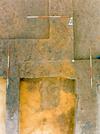The Sutton Hoo Research Project 1983-2001
Martin Carver, 2004. https://doi.org/10.5284/1000266. How to cite using this DOI
Data copyright © Prof Martin Carver unless otherwise stated
This work is licensed under the ADS Terms of Use and Access.
Primary contact
Prof
Martin
Carver
Department of Archaeology
University of York
King's Manor
Exhibition Square
York
YO1 7EP
England
Resource identifiers
- ADS Collection: 404
- DOI:https://doi.org/10.5284/1000266
- How to cite using this DOI
Downloads
Site Album : Mound 5

The Mound 5 platform. The box-trenches of the British Museum expedition of 1966-71 have been re-emptied, and the remaining mound platform cleaned to Horizon 4. 1987.

Inside a quarry pit (Int 48, F5, quarry pit for Mound 5). The lowest layer is backfill at the time of mound building in the 7th century. The dark layer which covers it is turf which formed on the backfill between the 7th and 10th centuries and above this is the 'pale sand', a podsolic soil pushed in by the plough in the 16th century, 1989.

Mound 5 on the completion of excavation in 1987. A satellite burial is being excavated in the middle ground, and Burial 12 in the foreground.






